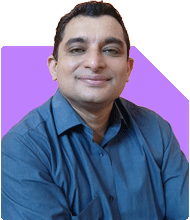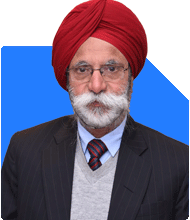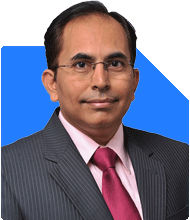How can I gain financial freedom by 40 with an existing 25 lakh FD?
Ramalingam Kalirajan |10902 Answers |Ask -Follow
Mutual Funds, Financial Planning Expert - Answered on Aug 22, 2024
He has an MBA in finance from the University of Madras and is a certified financial planner.
He is the director and chief financial planner at Holistic Investment, a Chennai-based firm that offers financial planning and wealth management advice.... more

मैं 26 साल का हूँ और मैंने 25 लाख की FD की है और मैं 7K (टाटा गारंटीड रिटर्न प्लान) की SIP कर रहा हूँ, जिसमें 3300 मार्केट लिंक्ड में जाता है और बाकी हिस्सा बीमा पॉलिसी में जाता है, जो मैच्योरिटी पर वापस कर दिया जाएगा। अवधि 21 साल है। म्यूचुअल फंड में 3K की और SIP। मेरी सारी SIP FD से मिलने वाले ब्याज पर चल रही है। फिलहाल मैं विदेश से लौटा हूँ और अपने देश में उपयुक्त नौकरी की तलाश कर रहा हूँ, इसलिए मैंने बचत को अधिकतम करने और बोझ को कम करने के लिए एक इको सिस्टम बनाया है। मुझे सलाह दें कि क्या मैं इस राशि का बेहतर प्रबंधन कर सकता हूँ क्योंकि मैं 40 साल तक 1 लाख की न्यूनतम मासिक आय के साथ वित्तीय स्वतंत्रता प्राप्त करना चाहता हूँ। मेरे पास कोई टर्म प्लान नहीं है। मेरे पास 10 लाख का स्वास्थ्य बीमा है और मैं अविवाहित हूँ।
26 वर्ष की आयु में, आपका प्राथमिक लक्ष्य 40 वर्ष की आयु तक वित्तीय स्वतंत्रता प्राप्त करना है। आप कम से कम 1 लाख रुपये की मासिक आय अर्जित करना चाहते हैं। वर्तमान में, आप भारत में वापस आ गए हैं और एक उपयुक्त नौकरी की तलाश कर रहे हैं।
मुख्य अवलोकन और सुधार के क्षेत्र
FD ब्याज पर निर्भरता:
आपके निवेश आपके FD से मिलने वाले ब्याज पर बहुत अधिक निर्भर करते हैं। हालांकि यह सुरक्षित लग सकता है, लेकिन FD पर ब्याज दर अक्सर समय के साथ मुद्रास्फीति के साथ तालमेल बिठाने में विफल हो जाती है। इससे आपके कोष की वृद्धि प्रभावित हो सकती है।
गारंटीड रिटर्न प्लान:
टाटा गारंटीड रिटर्न प्लान में बाजार से जुड़ा हुआ घटक है, लेकिन यह आपके निवेश का एक महत्वपूर्ण हिस्सा बीमा घटक में भी बांधता है। 21 वर्षों में, ऐसी योजनाओं से मिलने वाला रिटर्न आमतौर पर विशुद्ध रूप से बाजार आधारित निवेशों से कम होता है।
टर्म इंश्योरेंस की कमी:
आपके पास कोई टर्म प्लान नहीं है, जो आपके आश्रितों के लिए वित्तीय सुरक्षा जाल प्रदान करने के लिए महत्वपूर्ण है। वित्तीय सुरक्षा चाहने वाले किसी भी व्यक्ति के लिए एक शुद्ध टर्म प्लान जरूरी है।
स्वास्थ्य बीमा:
आपके पास 10 लाख रुपये का स्वास्थ्य बीमा है, जो एक अच्छी शुरुआत है। हालाँकि, जैसे-जैसे आप अपने करियर में आगे बढ़ते हैं और संभवतः एक परिवार शुरू करते हैं, आपको इस कवरेज पर फिर से विचार करने की आवश्यकता हो सकती है।
40 वर्ष की आयु तक वित्तीय स्वतंत्रता प्राप्त करने पर ध्यान दें:
40 वर्ष की आयु तक वित्तीय स्वतंत्रता प्राप्त करना एक महत्वाकांक्षी लेकिन प्राप्त करने योग्य लक्ष्य है। इसे प्राप्त करने के लिए, आपके निवेश को मुद्रास्फीति से कहीं अधिक दर से बढ़ना चाहिए। इसके लिए आपके निवेश दृष्टिकोण में रणनीतिक बदलाव की आवश्यकता है।
बेहतर वित्तीय प्रबंधन के लिए सुझाव
1. उच्च वृद्धि के लिए निवेश में विविधता लाएं
गारंटीड रिटर्न प्लान से हटें:
बीमा को निवेश के साथ मिलाने वाली योजनाओं से दूर जाने पर विचार करें। इन योजनाओं से मिलने वाला रिटर्न आमतौर पर लंबी अवधि में कम होता है। आप पॉलिसी को सरेंडर करने और फंड को म्यूचुअल फंड या अन्य उच्च-वृद्धि विकल्पों में पुनर्निर्देशित करने पर विचार कर सकते हैं।
म्यूचुअल फंड में SIP बढ़ाएँ:
सक्रिय रूप से प्रबंधित म्यूचुअल फंड, जब सही तरीके से चुने जाते हैं, तो गारंटीड रिटर्न प्लान की तुलना में अधिक रिटर्न दे सकते हैं। अगले 14 वर्षों में चक्रवृद्धि की शक्ति का लाभ उठाने के लिए म्यूचुअल फंड में अपनी SIP राशि बढ़ाएँ।
FD ब्याज पर निर्भरता से बचें:
अपने SIP को निधि देने के लिए FD ब्याज पर निर्भर रहने के बजाय, आपातकालीन ज़रूरतों के लिए या घर के लिए डाउन पेमेंट जैसे महत्वपूर्ण भविष्य के खर्चों को निधि देने के लिए FD कोष का उपयोग करें।
2. एक शुद्ध टर्म इंश्योरेंस प्लान पर विचार करें
टर्म प्लान में निवेश करें:
अपने वित्तीय लक्ष्यों को सुरक्षित करने के लिए एक टर्म इंश्योरेंस प्लान आवश्यक है। यह सुनिश्चित करता है कि अगर कुछ अप्रत्याशित होता है तो आपके आश्रितों को वित्तीय सहायता मिलेगी। टर्म प्लान का प्रीमियम अपेक्षाकृत कम होता है, खासकर जब कम उम्र में खरीदा जाता है।
3. लंबी अवधि के विकास के लिए इक्विटी एक्सपोजर बढ़ाएँ
इक्विटी में ज़्यादा निवेश करें:
40 की उम्र तक एक बड़ा फंड हासिल करने के लिए, आपको इक्विटी में अपना एक्सपोजर बढ़ाने की ज़रूरत है। इस एसेट क्लास में ज़्यादा रिटर्न देने की क्षमता है, खासकर 14 साल की अवधि में।
संतुलित दृष्टिकोण:
जबकि इक्विटी अस्थिर हो सकती है, डायवर्सिफाइड इक्विटी म्यूचुअल फंड के ज़रिए संतुलित दृष्टिकोण से जोखिम कम किया जा सकता है। ऐसे फंड चुनें जिनका ट्रैक रिकॉर्ड लगातार अच्छा रहा हो और जिन्हें अनुभवी फंड मैनेजर सक्रिय रूप से प्रबंधित करते हों।
4. इमरजेंसी फंड बनाने पर विचार करें
इमरजेंसी फंड बनाएँ:
लिक्विड फंड या उच्च ब्याज वाले बचत खाते में कम से कम 6 से 12 महीने के खर्च के बराबर पैसे अलग रखें। यह आपको अपने निवेश में कटौती किए बिना अप्रत्याशित खर्चों और नौकरी छूटने से बचाएगा।
5. वित्तीय स्वतंत्रता योजना
ज़रूरत के हिसाब से फंड की गणना करें:
25 लाख रुपये की मासिक आय उत्पन्न करने के लिए 14 साल बाद 1 लाख रुपये से ज़्यादा की बचत करने के लिए आपको एक बड़ी रकम की ज़रूरत होगी। सुरक्षित निकासी दर को मानते हुए, आपको लगभग 2.5 से 3 करोड़ रुपये की ज़रूरत हो सकती है।
नियमित निगरानी पर ध्यान दें:
अपने निवेश पोर्टफोलियो की नियमित निगरानी करें और ज़रूरत पड़ने पर उसमें बदलाव करें। बाज़ार के चक्रों के दौरान निवेशित बने रहना और मंदी के दौरान घबराने से बचना आपको सही रास्ते पर बने रहने में मदद करेगा।
पेशेवर मार्गदर्शन पर विचार करें:
हालाँकि आप पहले से ही सही फ़ैसले ले रहे हैं, लेकिन प्रमाणित वित्तीय योजनाकार (CFP) से सलाह लेने से आपको अपने निवेश पोर्टफोलियो को बेहतर बनाने के लिए खास रणनीति मिल सकती है।
6. कर-कुशल निवेश पर विचार करें
कर लाभों का लाभ उठाएँ:
अपने SIP को बढ़ाते समय, ELSS (इक्विटी-लिंक्ड सेविंग स्कीम) म्यूचुअल फंड में निवेश करने पर विचार करें, जो सेक्शन 80C के तहत कर लाभ प्रदान करते हैं। यह इक्विटी एक्सपोज़र प्रदान करते हुए आपकी कर योग्य आय को कम करने में मदद कर सकता है।
7. व्यक्तिगत और व्यावसायिक विकास पर ध्यान दें
खुद में निवेश करें:
चूँकि आप हाल ही में विदेश से लौटे हैं और नौकरी की तलाश कर रहे हैं, इसलिए व्यक्तिगत और व्यावसायिक विकास में निवेश करने से आपकी कमाई की क्षमता पर महत्वपूर्ण प्रभाव पड़ सकता है।
कौशल और नेटवर्क बनाएँ:
अपने कौशल को बढ़ाएँ या नए क्षेत्रों की खोज करें जो वर्तमान नौकरी बाजार में मांग में हैं। नेटवर्किंग आपके वित्तीय लक्ष्यों के साथ संरेखित एक बेहतर स्थिति हासिल करने में भी महत्वपूर्ण भूमिका निभा सकती है।
8. अपनी वित्तीय योजना की सालाना समीक्षा करें
वार्षिक समीक्षा:
जैसे-जैसे आपकी आय और जीवन की परिस्थितियाँ बदलती हैं, अपनी वित्तीय योजना की सालाना समीक्षा करें। अपने लक्ष्यों के साथ संरेखित रहने के लिए अपनी SIP, बीमा कवर और स्वास्थ्य बीमा को आवश्यकतानुसार समायोजित करें।
अपडेट रहें:
बाजार के रुझानों और कर कानूनों में बदलावों के बारे में जानकारी रखें जो आपके निवेश को प्रभावित कर सकते हैं। अपनी योजना के नियमित अपडेट आपको अपने रिटर्न को अधिकतम करने और अपने लक्ष्यों तक कुशलतापूर्वक पहुँचने में मदद करेंगे।
9. जीवन में बदलाव के लिए तैयार रहें
भविष्य की ज़िम्मेदारियों पर विचार करें:
जबकि आप वर्तमान में अविवाहित हैं, शादी या परिवार शुरू करने जैसी भविष्य की ज़िम्मेदारियाँ आपकी वित्तीय योजना को प्रभावित करेंगी। सुनिश्चित करें कि आपके वित्तीय निर्णय इन संभावित परिवर्तनों को समायोजित करने के लिए पर्याप्त लचीले हैं।
बड़े खर्चों की योजना बनाएं:
भविष्य में बड़े खर्चों पर विचार करें जैसे कि घर खरीदना या बच्चों की शिक्षा। इनकी योजना अभी से बनाना सुनिश्चित कर सकता है कि समय आने पर आप वित्तीय रूप से तैयार रहें।
अंत में
आपकी मौजूदा वित्तीय व्यवस्था ने एक मजबूत नींव रखी है। हालाँकि, 40 वर्ष की आयु तक वित्तीय स्वतंत्रता के अपने लक्ष्य को प्राप्त करने के लिए, आपको अपने निवेश को उच्च-विकास के रास्तों की ओर रणनीतिक रूप से स्थानांतरित करना चाहिए। इसमें गारंटीड रिटर्न प्लान से दूर जाना और सक्रिय रूप से प्रबंधित म्यूचुअल फंड में अपने SIP को बढ़ाना शामिल है। अपने वित्तीय लक्ष्यों की सुरक्षा के लिए शुद्ध टर्म इंश्योरेंस प्लान में निवेश करना भी महत्वपूर्ण है। जैसे-जैसे आप पेशेवर रूप से आगे बढ़ते हैं, अपनी वित्तीय योजना को सालाना फिर से देखना और परिष्कृत करना आपको अपने वित्तीय स्वतंत्रता लक्ष्यों को प्राप्त करने के लिए ट्रैक पर रखेगा।
सादर,
के. रामलिंगम, एमबीए, सीएफपी
मुख्य वित्तीय योजनाकार,
www.holisticinvestment.in
आप नीचे ऐसेही प्रश्न और उत्तर देखना पसंद कर सकते हैं
Ramalingam Kalirajan |10902 Answers |Ask -Follow
Mutual Funds, Financial Planning Expert - Answered on Apr 17, 2024
Jinal Mehta | Answer |Ask -Follow
Financial Planner - Answered on Jun 24, 2024
Ramalingam Kalirajan |10902 Answers |Ask -Follow
Mutual Funds, Financial Planning Expert - Answered on Aug 16, 2024
Ramalingam Kalirajan |10902 Answers |Ask -Follow
Mutual Funds, Financial Planning Expert - Answered on Aug 27, 2024
Ramalingam Kalirajan |10902 Answers |Ask -Follow
Mutual Funds, Financial Planning Expert - Answered on May 07, 2025
Anu Krishna |1749 Answers |Ask -Follow
Relationships Expert, Mind Coach - Answered on Dec 17, 2025
Anu Krishna |1749 Answers |Ask -Follow
Relationships Expert, Mind Coach - Answered on Dec 17, 2025
Radheshyam Zanwar |6748 Answers |Ask -Follow
MHT-CET, IIT-JEE, NEET-UG Expert - Answered on Dec 17, 2025
Anu Krishna |1749 Answers |Ask -Follow
Relationships Expert, Mind Coach - Answered on Dec 17, 2025
Dr Shakeeb Ahmed Khan |184 Answers |Ask -Follow
Physiotherapist - Answered on Dec 17, 2025
T S Khurana |538 Answers |Ask -Follow
Tax Expert - Answered on Dec 17, 2025
T S Khurana |538 Answers |Ask -Follow
Tax Expert - Answered on Dec 17, 2025
Janak Patel |72 Answers |Ask -Follow
MF, PF Expert - Answered on Dec 17, 2025
Ramalingam Kalirajan |10902 Answers |Ask -Follow
Mutual Funds, Financial Planning Expert - Answered on Dec 17, 2025
Samraat Jadhav |2511 Answers |Ask -Follow
Stock Market Expert - Answered on Dec 17, 2025





























